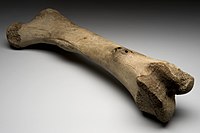
Photo from wikipedia
Giant cell tumors of the bone are rare, usually benign, tumors consisting of large, multinucleated bone cells. Remarkably, these tumors are characterized by aggressive growth. They tend to recur frequently… Click to show full abstract
Giant cell tumors of the bone are rare, usually benign, tumors consisting of large, multinucleated bone cells. Remarkably, these tumors are characterized by aggressive growth. They tend to recur frequently and, in rare cases, metastasize to the lungs. Previous studies tried to identify risk factors for lung metastasis by giant cell bone tumors. Those studies reported different results due to a small number of patients. Therefore, a particularly high risk associated with this type of bone tumor prompted this systematic review and meta-analysis to identify risk factors for the development of lung metastases. The risk factors for lung metastasis by giant cell bone tumors searched for in this study were gender, age, lung metastasis and recurrence period, follow-up time, primary or recurrent tumor, Campanacci grading, tumor localization, disease course, treatment of primary and recurrent tumors, and pulmonary metastases treated by surgery, radiation, and chemotherapy. This meta-analysis identified the features outlined above by comparing the groups of patients with giant cell bone tumors and lung metastases with the control group consisting of patients without lung metastases. The search for suitable studies revealed 63 publications with a total of 4,295 patients with giant cell bone tumors. Of these, 247 (5.8%; 95% confidence interval (95%CI) 5.1-6.5%) patients had lung metastases, with the odds ratio of 39.5 (95%CI 2.5-635.5%, p = 0.010). Further, the risk factors for lung metastases were the following: recurrence (p < 0.0001), lung metastasis time (p < 0.0001), Campanacci grade II (p = 0.028) and grade III (p = 0.006), localization in the lower limbs (p = 0.0007), curettage (p = 0.0005), and local irradiation of the primary tumor (p = 0.008). All studies showed a high-risk bias due to the absence of blinding of the participants, personnel, and outcome assessment. Special attention should be paid to tumor recurrence in the long follow-up time, since more advanced giant cell bone tumors, particularly in lower extremities, tend to reoccur and metastasize to the lung. Surgical treatment and local irradiation should be performed thoughtfully, with extended follow-up periods.
Journal Title: Advances in experimental medicine and biology
Year Published: 2019
Link to full text (if available)
Share on Social Media: Sign Up to like & get
recommendations!